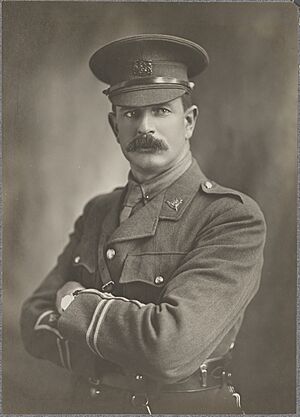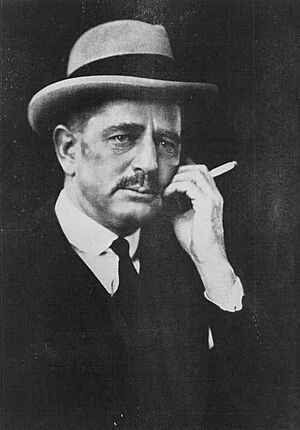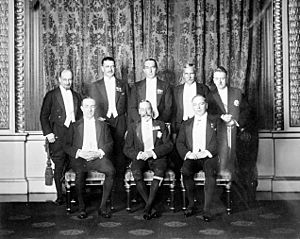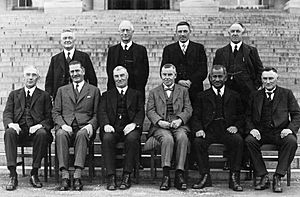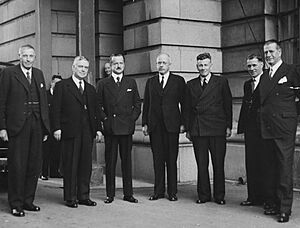Gordon Coates facts for kids
Quick facts for kids
Joseph Gordon Coates
|
|
|---|---|

Coates in 1931
|
|
| 21st Prime Minister of New Zealand | |
| In office 30 May 1925 – 10 December 1928 |
|
| Monarch | George V |
| Governor-General | Charles Fergusson |
| Preceded by | Francis Bell |
| Succeeded by | Sir Joseph Ward |
| 26th Minister of Finance | |
| In office 28 January 1933 – 6 December 1935 |
|
| Prime Minister | George Forbes |
| Preceded by | William Downie Stewart Jr |
| Succeeded by | Walter Nash |
| 11th Leader of the Opposition | |
| In office 10 December 1928 – 22 September 1931 |
|
| Preceded by | Sir Joseph Ward |
| Succeeded by | Harry Holland |
| 21st Minister of Native Affairs | |
| In office 7 February 1921 – 10 December 1928 |
|
| Prime Minister | William Massey Francis Bell Himself |
| Preceded by | William Herries |
| Succeeded by | Āpirana Ngata |
| 16th Postmaster-General | |
| In office 4 September 1919 – 30 May 1925 |
|
| Prime Minister | William Massey Francis Bell |
| Preceded by | Sir Joseph Ward |
| Succeeded by | James Parr |
| Member of the New Zealand Parliament for Kaipara |
|
| In office 14 December 1911 – 27 May 1943 |
|
| Preceded by | John Stallworthy |
| Succeeded by | Clifton Webb |
| Personal details | |
| Born | 3 February 1878 Hukatere, New Zealand |
| Died | 27 May 1943 (aged 65) Wellington, New Zealand |
| Political party | Reform |
| Spouse |
Marjorie Grace Coles
(m. 1914) |
| Children | 5 |
| Awards | MC and bar |
| Signature |  |
| Military service | |
| Allegiance | New Zealand Army |
| Years of service | 1916–18 |
| Rank | Major |
| Battles/wars | World War I |
Joseph Gordon Coates (3 February 1878 – 27 May 1943) was a very important New Zealand politician. He served as the 21st Prime Minister of New Zealand from 1925 to 1928. He was a leader of the Reform Party.
Coates grew up on a farm in Northland. He took charge of the farm at a young age. In 1911, he became a member of Parliament. He always cared about farming issues.
After fighting bravely in World War I, he became a government minister in 1919. He was in charge of areas like justice, public works, and Māori affairs. When Prime Minister William Massey died in 1925, Coates became the new Prime Minister.
He lost the election in 1928 but returned to government in 1931. He played a key role in a new coalition government. As Minister of Finance, he worked hard to fix the economy during the Great Depression. He died in 1943 while still serving in government during World War II.
Contents
Early Life and Family
Joseph Gordon Coates was born on 3 February 1878. His family lived on a sheep and cattle farm in Hukatere, near the Kaipara Harbour. He had to take on a lot of responsibility early because his father was unwell.
He went to a local school and his mother also taught him. Coates became a skilled horse rider. He had an accident that left him with a bad leg for the rest of his life.
Because many Māori lived in his area, Coates learned to speak some Māori. He understood their culture well. In 1914, he married Marjorie Grace Coles. They had five daughters together.
Start of His Political Career
Coates was very active in farmers' groups. His first step into politics was joining the Otamatea County Council in 1905. He later became the chairman of this council from 1913 to 1916.
He was also a commander of the local Mounted Rifle Volunteers. This helped him gain a good reputation in his area. In the 1911 election, Coates won the Kaipara seat in Parliament. He ran as an independent candidate.
At first, he often voted with the Liberal Party. He even helped their leader, Joseph Ward, stay as Prime Minister. However, Coates soon started to disagree with the Liberals. He strongly believed farmers should own their land outright, which the Liberals opposed.
Because of this, Coates voted against the Liberals in 1912. This helped the Reform Party come to power. By 1914, he officially joined the Reform Party. He was known for being friendly with politicians from all parties. His main goal was to improve services for the Far North.
When World War I started, Coates wanted to join the army. However, Prime Minister William Massey asked him to stay in Parliament. In November 1916, Coates finally got permission to enlist. He served with great courage and won a Military Cross and a bar.
When he returned to New Zealand, he was seen as a hero. In September 1919, Massey made him a minister. Coates became Minister of Justice, Postmaster-General, and Minister of Telegraphs. Later, he also became Minister of Public Works and Minister of Railways.
From March 1921, Coates served as Minister of Native Affairs. His knowledge of Māori language and culture was very helpful. He became good friends with Āpirana Ngata, a prominent Māori leader. Together, they worked to help Māori communities. As Minister of Public Works, Coates also helped set up rules for electricity generation. He started several large hydro power projects, like the Mangahao Power Station.
Becoming Prime Minister
Coates became more and more important in politics. Many people saw him as the natural choice to take over from Prime Minister Massey. When Massey passed away on 10 May 1925, Sir Francis Bell became a temporary Prime Minister.
On 27 May 1925, Coates was chosen as the Reform Party's new leader. He became Prime Minister on 30 May, at 47 years old. He was one of New Zealand's youngest prime ministers.
In June 1925, leaders of the Liberal Party met with Coates. They wanted to combine their parties to better fight the Labour Party. Coates and other Reform Party leaders did not think this was a good idea. They believed Reform could win the next election on its own.
Coates decided not to change his group of ministers before the election. The main topic of discussion was the budget, which showed a good amount of extra money. It lowered taxes and created new child welfare programs. These included a children's court system and support for children in need.
The 1925 Election Campaign
The Reform Party's campaign focused on Coates himself. He was young and born in New Zealand, which made him popular. Slogans like 'Coates and confidence' were used in newspapers. These slogans made him seem safe and decisive.
Coates did not follow one strict political idea. He was known for being practical and having good sense. The Reform Party's plan for the election was not very detailed. It talked about stable government, economic security, and equal chances for everyone. It also promised to finish public works projects.
Coates attracted large crowds during his speeches. He spoke about the need for 'strong and stable government'. He said he wanted to 'govern for all' and called his own views 'liberal and progressive'. This was unusual for the Reform Party, which was mostly conservative.
One of Coates' ministers, Sir James Parr, told a crowd that Coates was "no Tory." He said Coates "came from the people and was for the people." Coates also promised a plan to help people who were sick or unemployed. The Reform Party won a huge victory in the election, getting 55 out of 80 seats.
Challenges in Power
The big win in 1925 created high expectations for Coates. It was hard for him to live up to them. He was slow to choose his new ministers. He kept most of Massey's old ministers, making his group of ministers quite large.
Coates' reputation for being decisive started to fade. He created a new Prime Minister's Department to help with government work. In 1926, a special election was held in the Eden area. It was a disaster for Reform. Their votes were split, allowing the Labour Party to win the seat. This was a big change after Reform's huge win just five months earlier.
Coates kept his role as Minister of Native Affairs throughout his time as Prime Minister. He set up a special group to look into past Māori land confiscations. This was called the Sim commission.
By mid-1926, New Zealand faced serious problems. Prices for meat, wool, and butter were falling. This led to less money coming into the country and more people losing their jobs. Coates' government was criticized for the rising unemployment.
Coates passed emergency laws to help local councils create jobs. This did not help much. The government then thought about stopping people from moving to New Zealand. In August, a Family Allowances bill was introduced. This gave money to families with low incomes and more than two children. It was a new idea for its time.
Coates got a break from problems at home when he went to London in 1926. He led the New Zealand group at the 1926 Imperial Conference. At this meeting, New Zealand and other countries were declared equal partners within the British Empire. Coates and Sir Francis Bell did not fully agree with this idea. They wanted to keep strong ties with Britain.
Coates promised that New Zealand would pay £1 million to help build a naval base in Singapore. This base was important for defence with Britain and Australia. Later that year, Coates visited France and Belgium to see war cemeteries. He also visited Ireland and received an honorary degree.
On his way back to New Zealand, he visited Canada and the United States. He met with leaders there to discuss issues in the South Pacific. Soon after returning, he hosted Prince Albert, Duke of York (who later became King George VI) during his visit to New Zealand.
By February 1927, unemployment was still growing. Coates stopped immigration for several months to help. Farmers were also struggling because of the economic downturn. The Dairy Board wanted to set the price of butter in Britain to help farmers. The government had to convince them not to, as market conditions were too difficult.
Farmers were very unhappy with Coates and his government. They showed this in a special election in Raglan in September 1927. Reform lost this seat, which they usually won easily. Many farmers, who usually voted Reform, voted for other parties. Even newspapers friendly to Reform agreed that Coates' popularity had dropped since 1925.
Coates wanted to improve New Zealand's rural economy. He focused on building roads and transport. He supported projects like the Kopu Bridge to help farmers get their goods to market. He also approved the building of a railway between Rotorua and Taupo. He supported public works to create jobs for the unemployed.
As the Great Depression grew worse, Coates and the Reform Party faced a lot of criticism. Promises like the insurance scheme had to be put aside. In 1927, a former Reform Party organizer, Albert Davy, created a new United Party. This party was made up of former Liberal Party members and unhappy Reform Party supporters.
In the 1928 election, the Reform Party and the United Party won almost the same number of seats. When Parliament met, a vote was held to see if the government still had support. Both United and Labour voted against Coates' government. Coates lost the vote and had to step down as Prime Minister.
In Opposition
After losing the premiership, Coates became the Leader of the Opposition. This meant he led the main party that was not in government.
In 1930, the United government proposed a new law to deal with unemployment. The Labour Party did not support it because it required men to work for their unemployment pay. Coates, however, promised Reform's support to pass the law. He thought the government was not handling the depression well. He also saw a chance for his party to avoid blame for the economic problems.
However, the Reform Party conference in 1931 suggested working more closely with the United government. Coates was convinced to agree, even though he had doubts.
Forming a Coalition Government
In 1931, the Labour Party stopped supporting the United government. They disagreed with the government's economic plans, which they felt hurt workers. To prevent a new election, Coates and the Reform Party agreed to form a coalition with the United Party.
The leader of the United Party, George Forbes, remained Prime Minister. However, Coates and his Reform Party members got many important jobs. Coates' colleague, William Downie Stewart Jr, became Minister of Finance.
In the 1931 election, the coalition government stayed in power. But economic problems continued, and more people lost their jobs. Coates disagreed with William Downie Stewart Jr about how to fix the economy. Eventually, Coates himself became the Minister of Finance.
Prime Minister Forbes became less interested in leading, so Coates largely ran the government. As Minister of Finance, he lowered the value of New Zealand's money. He also set up the Reserve Bank of New Zealand in 1934. In 1935, he received the King George V Silver Jubilee Medal.
In the 1935 election, the coalition government lost badly. They won only 19 seats. Coates almost lost his own seat. The Labour Party won 53 seats and formed their first government, with Michael Joseph Savage as Prime Minister.
Later Political Career
After the coalition government's defeat, Coates stepped back from public life. He faced some financial difficulties because he no longer had his government salary. However, friends helped him out with a large sum of money.
In May 1936, the United and Reform parties joined together to form the National Party. Coates became a National Party Member of Parliament. Some people wanted him to lead the new party. But others felt that Coates and George Forbes were too linked to the country's economic problems.
Coates preferred Adam Hamilton, a former Reform member, to be the leader. Hamilton won the leadership vote. Coates was a loyal supporter of Hamilton and became the party's spokesperson for finance. He criticized the Labour government's economic policies. However, he also admitted that the previous government's strict spending cuts had caused too much hardship.
When World War II began, the Labour government invited Coates and Hamilton to join a special War Cabinet. This group would handle war-related matters. Their decision caused some disagreement within the National Party. Coates strongly believed that political arguments should stop during the war. He wanted Labour and National to work together.
He was happy when the two parties formed a joint War Administration. However, this administration soon broke down when the National Party chose to resign. Coates and Hamilton openly disagreed with this decision. The next day, they rejoined the War Cabinet at the invitation of Prime Minister Peter Fraser. Coates then became an Independent MP. He planned to run as an independent candidate in the next election.
Death
Coates' health began to get worse. He had smoked a lot for most of his life and had heart problems. On 27 May 1943, he collapsed and died in his office in Wellington.
Politicians from all parties paid tribute to him. The Labour Party, his former opponents, praised him more strongly than his own National Party colleagues.
Legacy
Coates' political style influenced Keith Holyoake, who later became Prime Minister himself. Holyoake saw Coates as his political role model. They both admired each other and shared similar views. They were against socialism and government control, and supported individual freedom and private business.
A small town in Auckland called Fernielea was renamed Coatesville in 1926, after Joseph Gordon Coates.
Images for kids


